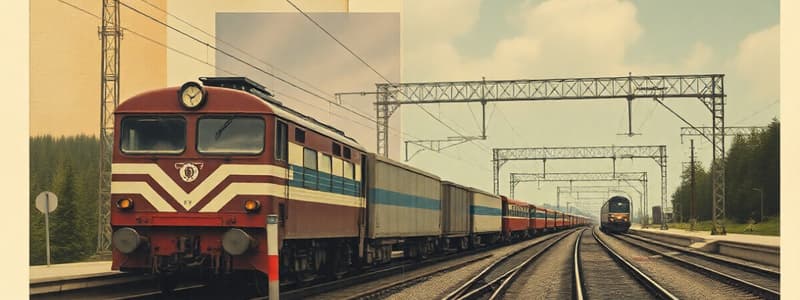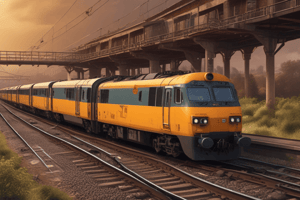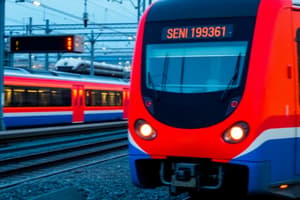Podcast
Questions and Answers
What is the purpose of the Schedule of Preferential Traffic?
What is the purpose of the Schedule of Preferential Traffic?
- To ensure that all commodities are treated equally regardless of urgency.
- To regulate the movement of wagon load traffic during inadequate transport availability. (correct)
- To allow for free trade among different commodity categories.
- To prioritize the movement of non-essential goods over essential ones.
Which authority decides the Priority Schedule for preferential traffic?
Which authority decides the Priority Schedule for preferential traffic?
- Central Government Transport Department
- Regional Railway Authorities
- Ministry of Railways
- Traffic Transportation Directorate of Railway Board (correct)
Under the Rationalization Order, how is the freight charged for transport?
Under the Rationalization Order, how is the freight charged for transport?
- By a route that may not be the shortest as designated by the Railway Board. (correct)
- Only when specified by the commodities' sponsoring authorities.
- Based solely on the longest route available.
- Always based on the shortest route.
Which section under the Indian Railways Act empowers the Railway Board to regulate freight charging?
Which section under the Indian Railways Act empowers the Railway Board to regulate freight charging?
Which statement about the classification of traffic is true?
Which statement about the classification of traffic is true?
What is the consequence of traffic classification under the Schedule of Preferential Traffic?
What is the consequence of traffic classification under the Schedule of Preferential Traffic?
Which body is responsible for issuing the Rationalization Order regarding freight charging routes?
Which body is responsible for issuing the Rationalization Order regarding freight charging routes?
What is the implication of Revised Rule 125 under the IRCA Goods Tariff?
What is the implication of Revised Rule 125 under the IRCA Goods Tariff?
Under the Schedule of Preferential Traffic, how many traffic categories exist?
Under the Schedule of Preferential Traffic, how many traffic categories exist?
What must be done with a Priority Schedule related to traffic classification?
What must be done with a Priority Schedule related to traffic classification?
What factors determine the preference given to certain commodities in the Schedule of Preferential Traffic?
What factors determine the preference given to certain commodities in the Schedule of Preferential Traffic?
Which of the following categories reflects the highest preference in traffic classification?
Which of the following categories reflects the highest preference in traffic classification?
What is a necessary condition for the charging of freight by the shortest route under the Rationalization Order?
What is a necessary condition for the charging of freight by the shortest route under the Rationalization Order?
Who is responsible for issuing the Priority Schedule in the preferential traffic system?
Who is responsible for issuing the Priority Schedule in the preferential traffic system?
What does the Rationalization Order allow the Railway Board to do in terms of freight routes?
What does the Rationalization Order allow the Railway Board to do in terms of freight routes?
What happens to commodities registered in lower traffic categories compared to those in higher categories?
What happens to commodities registered in lower traffic categories compared to those in higher categories?
Who is responsible for issuing the Rationalization Order concerning freight charging routes?
Who is responsible for issuing the Rationalization Order concerning freight charging routes?
What may be charged for freight under the Rationalization Order according to the content provided?
What may be charged for freight under the Rationalization Order according to the content provided?
What type of commodities get preference according to the Schedule of Preferential Traffic?
What type of commodities get preference according to the Schedule of Preferential Traffic?
What does the Priority Schedule list regarding traffic?
What does the Priority Schedule list regarding traffic?
What is indicated by the Rationalization Order related to freight charges?
What is indicated by the Rationalization Order related to freight charges?
Under what condition will goods be dispatched by the route optionally feasible?
Under what condition will goods be dispatched by the route optionally feasible?
What does Revised Rule 125 of IRCA specify about freight charges?
What does Revised Rule 125 of IRCA specify about freight charges?
Which of the following statements is true about the classification of traffic?
Which of the following statements is true about the classification of traffic?
What is the main goal of the Schedule of Preferential Traffic?
What is the main goal of the Schedule of Preferential Traffic?
What happens if a commodity is registered in a lower traffic category?
What happens if a commodity is registered in a lower traffic category?
Which organization is responsible for listing the Sponsoring and Accepting Authority for traffic?
Which organization is responsible for listing the Sponsoring and Accepting Authority for traffic?
Under the Rationalization Order, where are freight charges issued when the shortest route is not available?
Under the Rationalization Order, where are freight charges issued when the shortest route is not available?
What determines the dispatch route for goods under the Rationalization Order when no specific instructions are available?
What determines the dispatch route for goods under the Rationalization Order when no specific instructions are available?
What does the Indian Railways Act empower the Railway Board to do regarding freight routes?
What does the Indian Railways Act empower the Railway Board to do regarding freight routes?
What is the maximum number of categories defined for traffic under the Schedule of Preferential Traffic?
What is the maximum number of categories defined for traffic under the Schedule of Preferential Traffic?
What process is involved in determining which commodities receive transport preference?
What process is involved in determining which commodities receive transport preference?
What must occur for freight charges to be levied by the shortest route pursuant to the Rationalization Order?
What must occur for freight charges to be levied by the shortest route pursuant to the Rationalization Order?
Under the guidelines provided, what is the relation between the Traffic Transportation Directorate and the Priority Schedule?
Under the guidelines provided, what is the relation between the Traffic Transportation Directorate and the Priority Schedule?
What does Revised Rule 125 of IRCA Goods Tariff specify about freight charges?
What does Revised Rule 125 of IRCA Goods Tariff specify about freight charges?
What is the lowest traffic category that can be given preference over another category?
What is the lowest traffic category that can be given preference over another category?
Which authority issues the Rationalization Order to determine freight charging routes?
Which authority issues the Rationalization Order to determine freight charging routes?
How are freight charges determined when no specific instructions are issued?
How are freight charges determined when no specific instructions are issued?
According to the Schedule of Preferential Traffic, what is primarily needed to grant preference to certain commodities?
According to the Schedule of Preferential Traffic, what is primarily needed to grant preference to certain commodities?
Which regulation allows the Railway Board to charge freight not based on the shortest route?
Which regulation allows the Railway Board to charge freight not based on the shortest route?
What is indicated in the Priority Schedule regarding traffic?
What is indicated in the Priority Schedule regarding traffic?
What must be done to request a revised Priority Schedule from the Railway Board?
What must be done to request a revised Priority Schedule from the Railway Board?
What might lead to a deviation from the shortest route for freight charges?
What might lead to a deviation from the shortest route for freight charges?
What does the term 'Preferential Traffic' specifically refer to in the context provided?
What does the term 'Preferential Traffic' specifically refer to in the context provided?
In the classification system of traffic, which category is classified highest?
In the classification system of traffic, which category is classified highest?
Flashcards are hidden until you start studying
Study Notes
Preferential Schedule
- The Railway Board, under the Railways Act of 1989, regulates wagon load traffic movement through a Schedule of Preferential Traffic.
- This schedule prioritizes essential commodities and urgent movements when available transport is insufficient.
- Traffic is categorized into four tiers: A, B, C, and D, with higher categories taking precedence over lower ones, regardless of registration date.
- The Traffic Transportation Directorate of the Railway Board determines the Priority Schedule.
- The Priority Schedule also identifies the Sponsoring Authority and Accepting Authority for programmed traffic.
- The Priority Schedule can be accessed on the Indian Railways website.
Rationalization Order
- The Railway Board, under the Railways Act of 1989, can charge freight over routes that are not the shortest between the loading point and destination.
- These routes are determined by the Rationalization Order, issued by the traffic transportation branch of the Railway Board.
- Revised rule 125 of IRCA Goods Tariff Part I (Volume I) dictates, unless specified in writing by the center or their authorized agent, goods are dispatched by the most feasible route, and freight charges are levied by the shortest route.
- However, freight charging on the shortest route is subject to any instructions issued by the Rationalization Order.
Preferential Schedule
- The Schedule of Preferential Traffic, governed by Section 71 of the Railways Act, 1989, prioritizes certain commodities and urgent movements when rail capacity is limited.
- Traffic is categorized into four tiers: A, B, C, and D, with higher tiers having priority over lower ones, regardless of registration time.
- The Traffic Transportation Directorate of Railway Board determines the schedule.
- The schedule specifies the Sponsoring Authority and Accepting Authority for programmed traffic.
Rationalization Order
- The Railway Board is authorized by Section 71 of the Indian Railways Act 1989 to charge freight based on routes that are not necessarily the shortest.
- The Rationalization Order, issued by the Traffic Transportation Branch of the Railway Board outlines these routes for freight charges.
- Revised Rule 125 of the IRCA Goods Tariff Part I (Volume-I) states that goods will be transported via the shortest route unless explicitly specified otherwise by the central authority or its agent.
- However, freight charging via the shortest route is subject to any Rationalization Order issued by the Railway Board.
Preferential Schedule
- The movement of wagon load traffic is regulated by the Schedule of Preferential Traffic, laid down by the Central Government (Railway Board) under Section 71 of the Railways Act, 1989.
- This schedule aims to ensure that essential commodities and urgent movements receive priority when available transport is limited.
- Traffic is categorized into four classes: A, B, C, and D.
- Lower category commodities cannot overtake higher category commodities, even if registered earlier.
- The Priority Schedule is decided by the Traffic Transportation Directorate of the Railway Board.
- It outlines the Sponsoring Authority and Accepting Authority for programmed traffic.
Rationalization Order
- The Railway Board has the authority to charge freight over routes that are not the shortest between the loading and destination points under Section 71 of the Indian Railways Act, 1989.
- The Rationalization order, issued by the traffic transportation branch of the Railway Board, specifies the route for freight charging.
- Revised rule 125 of IRCA Goods Tariff Part I (Volume-I), implemented through Board’s letter no. ECR 1125/94/3 dated 6/10/94, directs that unless a specific written instruction from the center or their authorized agent exists, goods will be shipped by the most feasible route, and freight charges will be calculated based on the shortest route.
- However, charging freight by the shortest route is subject to any instructions issued in the Rationalization order.
Preferential Schedule
- The Central Government (Railway Board) regulates the movement of wagon load traffic through the Schedule of Preferential Traffic under Section 71 of the Railways Act, 1989.
- The schedule prioritizes essential commodities and urgent movements when available transport is insufficient to meet demand.
- Traffic is categorized into four levels (A, B, C, and D), with higher categories receiving preference over lower categories regardless of registration time.
- The Traffic Transportation Directorate of Railway Board decides the Priority Schedule and lists the Sponsoring and Accepting Authorities for programmed traffic.
- The Priority Schedule is accessible on the Indian Railways website.
Rationalization Order
- The Railway Board is authorized under Section 71 of the Indian Railways Act, 1989, to charge freight based on a route that may not be the shortest between the starting and ending points.
- The Rationalization Order detailing the freight charging route is issued by the traffic transportation branch of the Railway Board.
- Revised rule 125 of IRCA Goods Tariff Part I (Volume-I) specifies, through Board letter ECR 1125/94/3 dated 6/10/94, that goods will be shipped through the most feasible route unless a written instruction from the center or their authorized agent dictates otherwise.
- Freight charges will be levied based on the shortest route despite the chosen shipping route.
- However, the shortest route freight charging is subject to any instructions issued by the Rationalization Order from time to time.
Preferential Schedule
- The Central Government (Railway Board) regulates the movement of wagon load traffic through a Schedule of Preferential Traffic.
- The Schedule of Preferential Traffic is designated to ensure essential commodities and urgent movements receive priority when available transport is limited.
- Traffic is categorized into four classes: A, B, C, and D.
- Lower category commodities cannot supersede higher category commodities, regardless of registration time.
- The Traffic Transportation Directorate of the Railway Board determines the Priority Schedule.
- The Priority Schedule lists the Sponsoring Authority and Accepting Authority for programmed traffic.
- The Priority Schedule is available on the Indian Railways website.
Rationalization Order
- The Railway Board is authorized by Section 71 of the Indian Railways Act 1989 to charge freight over routes that may not be the shortest between the origin and destination.
- The Rationalization order, issued by the Traffic Transportation Branch of the Railway Board, dictates the route for freight charges.
- A Board's Letter (ECR 1125/94/3 dated 6/10/94) revised Rule 125 of IRCA Goods Tariff Part I (Volume-I) to mandate that goods be shipped using the most convenient route unless a specific written instruction from the center or authorized agent stipulates otherwise.
- Freight charges are levied based on the shortest route, unless otherwise specified by the Rationalization order.
Preferential Schedule
- The movement of wagon load traffic is regulated by the Schedule of Preferential Traffic.
- The Schedule is established by the Central Government (Railway Board) under Section 71 of the Railways Act, 1989.
- Its purpose is to prioritize essential commodities and urgent movements when transportation is insufficient.
- Traffic is categorized into four levels: A, B, C, and D.
- Higher category commodities are prioritized over lower categories, regardless of registration time.
- The Traffic Transportation Directorate of Railway Board determines the Priority Schedule.
- The Schedule lists the Sponsoring and Accepting Authorities for programmed traffic.
- It can be found on the Indian Railways website.
Rationalization Order
- Section 71 of the Indian Railways Act 1989 empowers the Railway Board to charge freight based on routes other than the shortest.
- The Rationalization order, specifying the freight charging route, is issued by the traffic transportation branch of the Railway Board.
- Revised rule 125 of IRCA Goods Tariff Part I (Volume-I) directs goods to be dispatched by the most feasible route unless specifically instructed otherwise.
- Freight charges will be levied based on the shortest route except for instructions issued under the Rationalization order.
Studying That Suits You
Use AI to generate personalized quizzes and flashcards to suit your learning preferences.




